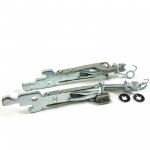- Joined
- Jul 1, 2012
- Messages
- 425
- Points
- 226
To set the scene, I adjusted my rear brake shoes/drums back at the beginning of February for the MOT. Every year the handbrake needs adjusting for it to pass.
So I adjusted both sides, set the handbrake so it just started to bite after 3 clicks, all has been fine in the 7 or so weeks since.
Yesterday I was going along a main road at around 55, when all of a sudden the car stank of burning friction material. Fortunately I was nearly home, so when I stopped and got out, the rear N/S stank of burnt friction material......I touched the drum....OUCH!! It was blisteringly hot.
So this morning I jacked it up.....and the wheel span freely.
I took the wheel off, and the drum would turn freely by hand. However, as soon as I tried to take the drum off, it was stuck solid on the shoes. A hammer and pry bars managed to get it off in the end.
There was nothing obviously wrong inside.....the shoes and springs were in place, adjuster was in its correct place, cylinder (all the rear brake components are just over a year old) was fully compressed in as you'd expect.
So I adjusted the shoes in a bit, and refitted.....and it was fine this afternoon.
Has anyone got any idea what might have caused it?
What confuses me is that it began while driving on a straight road, and not even touching the brake or handbrake.
So I adjusted both sides, set the handbrake so it just started to bite after 3 clicks, all has been fine in the 7 or so weeks since.
Yesterday I was going along a main road at around 55, when all of a sudden the car stank of burning friction material. Fortunately I was nearly home, so when I stopped and got out, the rear N/S stank of burnt friction material......I touched the drum....OUCH!! It was blisteringly hot.
So this morning I jacked it up.....and the wheel span freely.
I took the wheel off, and the drum would turn freely by hand. However, as soon as I tried to take the drum off, it was stuck solid on the shoes. A hammer and pry bars managed to get it off in the end.
There was nothing obviously wrong inside.....the shoes and springs were in place, adjuster was in its correct place, cylinder (all the rear brake components are just over a year old) was fully compressed in as you'd expect.
So I adjusted the shoes in a bit, and refitted.....and it was fine this afternoon.
Has anyone got any idea what might have caused it?
What confuses me is that it began while driving on a straight road, and not even touching the brake or handbrake.


